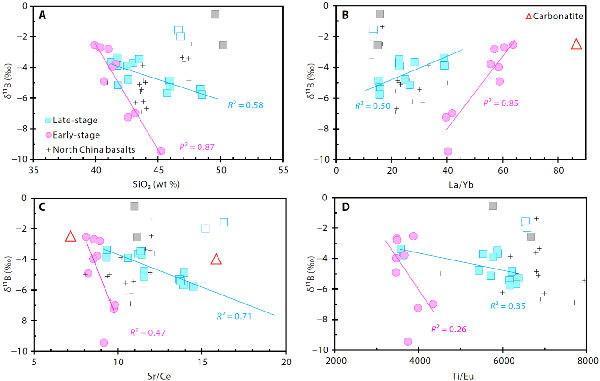Volatiles are crucial for sustaining life and the Earth's habitability, with subduction zones being the main pathways for these materials to enter the mantle. However, the devolatilization of subducting slabs may impede the recycling of volatiles like carbon. Boron, a moderately volatile element with strong fluid mobility, serves as a useful tracer for tracking the recycling of volatiles through its isotopic composition (δ¹¹B).
Studies of boron isotopes in oceanic basalts face challenges from seawater alteration and eruption contamination, making it difficult to link boron isotopes to mantle processes. This contributes to uncertainties about the recycling of boron and other surface-derived volatiles into the deep mantle.
To address this issue, associate Prof. XU Rong from the Institute of Geochemistry of the Chinese Academy of Sciences, along with Prof. CAI Yue from the Nanjing Institute of Geology and Palaeontology and their collaborators, employed advanced, high-precision boron isotope analytical techniques to study two groups of relatively primitive Cenozoic basalts from Zhejiang Province in southeastern China. Their findings were published in Science Advances.
The researchers found clear correlations between boron isotopes and other geochemical indicators, revealing contributions from three different mantle source components. Among these components, the lightest boron isotope end-member indicates a strongly dehydrated oceanic crust, while another light boron isotope end-member reflects a metasomatized continental lithospheric mantle. Notably, both groups of basalts share a common heavy boron isotope end-member.
Through detailed analysis and considering its low B/Ce ratio, the researchers concluded that the heavy boron isotope signature cannot be attributed to contributions from boron-rich fluids-such as those from subducted oceanic crust, sediments, or serpentine, which were previously thought to be sources of heavy δ¹¹B. Instead, the strong correlation between heavy boron isotopes and carbonate-related indicators suggests a significant contribution from recycled surface carbonates.
The study demonstrates that surface-derived carbonates can transport heavy boron isotope signatures deep into the mantle transition zone (410-660 km). These signatures can then be recorded by intraplate basalts, deep-sourced carbonatites, and possibly even super-deep diamonds.
This study provides new insights into the deep recycling of subducted materials, including volatiles, and highlights the role of surface carbonates in delivering heavy boron isotopic signatures to the mantle source region of intraplate basalts.

Relationships between boron isotopes and other geochemical indicators (Image by IGCAS)






